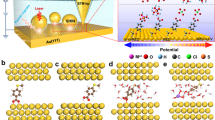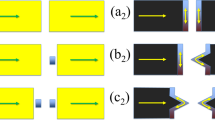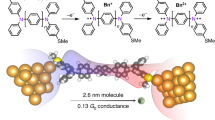Abstract
Charge transport through single molecules can be influenced by the charge and spin states of redox-active metal centres placed in the transport pathway. These intrinsic properties are usually manipulated by varying the molecule's electrochemical and magnetic environment, a procedure that requires complex setups with multiple terminals. Here we show that oxidation and reduction of organometallic compounds containing either Fe, Ru or Mo centres can solely be triggered by the electric field applied to a two-terminal molecular junction. Whereas all compounds exhibit bias-dependent hysteresis, the Mo-containing compound additionally shows an abrupt voltage-induced conductance switching, yielding high-to-low current ratios exceeding 1,000 at bias voltages of less than 1.0 V. Density functional theory calculations identify a localized, redox-active molecular orbital that is weakly coupled to the electrodes and closely aligned with the Fermi energy of the leads because of the spin-polarized ground state unique to the Mo centre. This situation provides an additional slow and incoherent hopping channel for transport, triggering a transient charging effect in the entire molecule with a strong hysteresis and large high-to-low current ratios.
This is a preview of subscription content, access via your institution
Access options
Subscribe to this journal
Receive 12 print issues and online access
$259.00 per year
only $21.58 per issue
Buy this article
- Purchase on Springer Link
- Instant access to full article PDF
Prices may be subject to local taxes which are calculated during checkout




Similar content being viewed by others
References
Van der Molen, S. J. & Liljeroth, P. Charge transport through molecular switches. J. Phys. 22, 133001 (2010).
Song, H. et al. Observation of molecular orbital gating. Nature 462, 1039–1043 (2009).
Liao, J. et al. Cyclic conductance switching in networks of redox-active molecular junctions. Nano Lett. 10, 759–764 (2010).
Irie, M. Diarylethenes for memories and switches. Chem. Rev. 100, 1685–1716 (2000).
Dulic, D. et al. One-way optoelectronic switching of photochromic molecules on gold. Phys. Rev. Lett. 91, 207402 (2003).
Kronemeijer, A. J. et al. Reversible conductance switching in molecular devices. Adv. Mat. 20, 1467–1473 (2008).
Van der Molen, S. J. et al. Light-controlled conductance switching of ordered metal–molecule-metal devices. Nano Lett. 9, 76–80 (2009).
Quek, S. Y. et al. Mechanically controlled binary conductance switching of a single-molecule junction. Nature Nanotech. 4, 230–234 (2009).
Blum, A. S. et al. Molecularly inherent voltage-controlled conductance switching. Nature Mater. 4, 167–172 (2005).
Lörtscher, E., Ciszek, J. W., Tour, J. M. & Riel, H. Reversible and controllable switching of a single-molecule junction. Small 2, 973–977 (2006).
Meded, V., Bagrets, A., Arnold, A. & Evers, F. Molecular switch controlled by pulsed bias voltages. Small 5, 2218–2223 (2009).
Kahn, O. & Martinez, C. J. Spin-transition polymers: From molecular materials toward memory devices. Science 279, 44–48 (1998).
Sato, O., Tao, J. & Zhand, Y.-Z. Control of magnetic properties through external stimuli. Angew. Chem. Int. Ed. 46, 2152–2187 (2007).
Baadji, N. et al. Electrostatic spin crossover effect in polar magnetic molecules. Nature Mater. 8, 813–817 (2009).
Park, J. et al. Coulomb blockade and the Kondo effect in single-atom transistors. Nature 417, 722–725 (2002).
Prins, F., Morabal-Capilla, M., Osorio, E. A., Coronado, E. & van der Zant, H. S. J. Room-temperature electrical addressing of a bistable spin-crossover molecular system. Adv. Mater. 23, 545–1549 (2011).
Wagner, S. et al. Switching of a coupled spin pair in a single-molecule junction. Nature Nanotech. 8, 575–579 (2013).
Kim, B. et al. Temperature and length dependence of charge transport in redox-active molecular wires incorporating Ruthenium(II) bis(σ-arylacetylide) complexes. J. Phys. Chem. C 111, 7521–7526 (2007).
Luo, L. et al. Length and temperature dependent conduction of Ruthenium-containing redox-active molecular wires. J. Phys. Chem. C 115, 19955–19961 (2011).
Ruben, M. et al. Charge transport through a cardan-joint molecule. Small 4, 2229–2235 (2008).
Meng, F. et al. Photo-modulable molecular transport junctions based on organometallic molecular wires. Chem. Sci. 3, 3113–3118 (2012).
Meng, F. et al. Orthogonally modulated molecular transport junctions for resettable electronic logic gates. Nature Commun. 5, 3023 (2014).
Ponce, J. et al. Effect of metal complexation on the conductance of single-molecular wires measured at room temperature. J. Am. Chem. Soc. 136, 8314–8322 (2014).
Schwarz, F. et al. High-conductive organometallic molecular wires with delocalized electron systems strongly coupled to metal electrodes. Nano Lett. 14, 5932–5940 (2014).
Lissel, F. et al. Organometallic single-molecule electronics: Tuning electron transport through (diphosphine)2FeC4Fe(diphosphine)2 building blocks by varying the molecule–metal anchoring scheme from coordinative to covalent. J. Am. Chem. Soc. 136, 14560–14569 (2014).
Reed, M. A., Zhou, C., Muller, C. J., Burgin, T. P. & Tour, J. M. Conductance of a molecular junction. Science 278, 252–254 (1997).
Zotti, L. A. et al. Revealing the role of anchoring groups in the electrical conduction through single-molecule junctions. Small 6, 1529–1535 (2010).
Wuttke, E. et al. Divinylphenylene- and ethynylvinylphenylene-bridged mono-, di-, and triruthenium complexes for covalent binding to gold electrodes. Organometallics 33, 4672–4686 (2014).
Touchard, D. et al. Vinylidene-, Alkynyl-, and trans-bis(alkynyl)ruthenium complexes. Crystal structure of trans-[Ru(NH3)(C C-Ph)(Ph2PCH2CH2PPh2)2]PF6 . Organometallics 16, 3640–3648 (1997).
Lörtscher, E., Weber, H. B. & Riel, H. Statistical approach to investigating transport through single molecules. Phys. Rev. Lett. 98, 176807 (2007).
Galperin, M., Ratner, M. & Nitzan, A. Hysteresis, switching, and negative differential resistance in molecular junctions: A polaron model. Nano Lett. 5, 125–130 (2005).
Kuznetsov, A. M. Negative differential resistance and switching behavior of redox-mediated tunnel contact. J. Chem. Phys 127, 084710 (2007).
Migliore, A. & Nitzan, A. Irreversibility and hysteresis in redox molecular conduction junctions. J. Am. Chem. Soc. 135, 9420–9432 (2013).
Kastlunger, G. & Stadler, R. Charge localization on a redox-active single-molecule junction and its influence on coherent electron transport. Phys. Rev. B 88, 035418 (2013).
Kastlunger, G. & Stadler, R. Density functional theory based calculations of the transfer integral in a redox-active single-molecule junction. Phys. Rev. B 89, 115412 (2014).
Kastlunger, G. & Stadler, R. A density functional theory based direct comparison of coherent tunnelling and electron hopping in redox-active single molecule junctions. Phys. Rev. B 91, 125410 (2015).
Brandbyge, M., Mozos, J.-L., Taylor, J. & Stokbro, K. Density-functional method for nonequilibrium electron transport. Phys. Rev. B 65, 165401 (2002).
Xue, Y., Datta, S. & Ratner, M. A. First-principles based matrix Green's function approach to molecular electronic devices: General formalism. Chem. Phys. 281, 151–170 (2002).
Rocha, A. R. et al. Towards molecular spintronics. Nature Mater. 4, 335–339 (2005).
Mortensen, J. J., Hansen, L. B. & Jacobsen, K. W. Real-space grid implementation of the projector augmented wave method. Phys. Rev. B 71, 035109 (2005).
Enkovaara, J. et al. Electronic structure calculations with GPAW: A real-space implementation of the projector augmented-wave method. J. Phys. 22, 253202 (2010).
Schmaus, S. et al. Giant magnetoresistance through a single molecule. Nature Nanotech. 6, 185–189 (2011).
Acknowledgements
We are grateful to M. Koch for support with the synthesis of the end groups and to O. Blacque for single-crystal X-ray diffraction. We also acknowledge G. Puebla-Hellmann, V. Schmidt, and F. Evers for scientific discussions, and M. Tschudy, U. Drechsler and Ch. Rettner for technical assistance. We thank W. Riess and B. Michel for continuous support. Funding from the National Research Program “Smart Materials” (NRP 62, grant 406240-126142) of the Swiss National Science Foundation (SNSF) and the University of Zürich is gratefully acknowledged. G.K. and R.S. are currently supported by the Austrian Science Fund FWF, project Nos. P22548 and P27272, and are deeply indebted to the Vienna Scientific Cluster VSC, on whose computing facilities all DFT calculations were performed (project No. 70174). In addition, G.K. receives a grant co-sponsored by the Austrian Academy of Science ÖAW, Springer and the Austrian Chemical Society GÖCH.
Author information
Authors and Affiliations
Contributions
F.L., C.E.-L., S.N.S., K.V., and H.B. designed and synthesized the compounds. F.S., and E.L. set up and performed the experiments and the data analysis. G.K. and R.S. carried out the calculations. F.S., G.K., K.V., H.B., R.S. and E.L. wrote the paper. All authors discussed the results and commented on the manuscript.
Corresponding author
Ethics declarations
Competing interests
The authors declare no competing financial interests.
Supplementary information
Supplementary information
Supplementary information (PDF 2812 kb)
Rights and permissions
About this article
Cite this article
Schwarz, F., Kastlunger, G., Lissel, F. et al. Field-induced conductance switching by charge-state alternation in organometallic single-molecule junctions. Nature Nanotech 11, 170–176 (2016). https://doi.org/10.1038/nnano.2015.255
Received:
Accepted:
Published:
Issue Date:
DOI: https://doi.org/10.1038/nnano.2015.255
This article is cited by
-
An artificial synapse based on molecular junctions
Nature Communications (2023)
-
Local cation-tuned reversible single-molecule switch in electric double layer
Nature Communications (2023)
-
Interplay of structural chirality, electron spin and topological orbital in chiral molecular spin valves
Nature Communications (2023)
-
Dynamic molecular switches with hysteretic negative differential conductance emulating synaptic behaviour
Nature Materials (2022)
-
Highly nonlinear transport across single-molecule junctions via destructive quantum interference
Nature Nanotechnology (2021)



